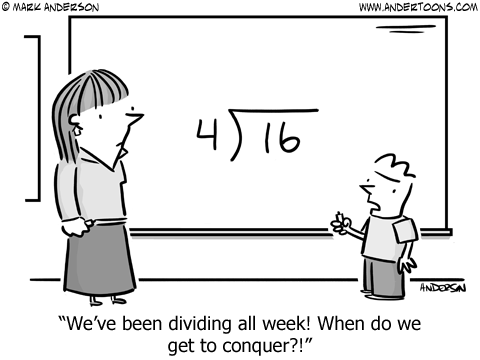Why Is Division Difficult?
by Melissa Braaten

When it comes to the four basic operations, division is often the one that students find the most difficult. Many adult education students, especially at beginning levels of math, have gaps in their understanding of both when and how to divide. Why does this operation seem to cause more problems than the rest? A lack of fluency in basic multiplication facts can sometimes be a factor, but there is more about division that can cause difficulties.
Addition and multiplication have an important property that makes them easier and more intuitive for many people than subtraction and division. When we add,
5 + 6 + 7 + 8 = 26
all the numbers being added (5, 6, 7, and 8) are called addends. They are all performing the same “role” in the calculation. Because of this, we have a lot of flexibility in how we add them. We can rearrange the order (Commutative Property)
8 + 5 + 7 + 6 = 26
or regroup them (Associative Property)
5 + (6 + 7) + 8 = 26
without changing the result.
Multiplication has this same characteristic. The numbers we multiply (in the example below, 2, 3, and 4) are all called factors
2 x 3 x 4 = 24
and are interchangeable when it comes to calculations.
4 x 2 x 3 = 24 (Commutative Property)
2 x (3 x 4) = 24 (Associative Property)
Subtraction and division are different. The numbers used in division, for example, are called the dividend and the divisor. They have different names because they are performing different “roles” in the calculation.
| Dividend | Divisor | Quotient | ||
| 20 | ÷ | 5 | = | 4 |
If we consider division’s relationship to multiplication, 5 and 4 can also be seen as factors, with a product (result) of 20.
5 x 4 = 20
Because factors are interchangeable, there is flexibility in division
20 ÷ 5 = 4 and 20 ÷ 4 = 5
but the flexibility is between the divisor and the quotient, not the dividend (20). The dividend has a unique role in division and can’t be exchanged without changing the meaning of the calculation.
For example,
20 ÷ 5 = 4 could model a situation where $20 is shared equally among 5 people, whereas
5 ÷ 20 = .25 would mean that $5 is being shared among 20 people, a very different situation with a different result.
Division is also the only one of the basic operations that can produce fractional results and remainders from whole number inputs. Physical/visual representations and considering context are important to help students make sense of the idea of a remainder. For beginning level students, keep remainders as whole numbers with labels (62 ÷ 12 = 5, remainder 2) and leave decimal or fraction representations until later.
Want to see examples of physical/visual representations and division contexts, as well as teaching suggestions for different levels of students? Click here to view the complete resource.

Melissa Braaten is an adult education instructor at Catholic Charities Haitian Multi-Services Center in Dorchester, MA. Melissa has taught ASE and pre-ASE math and reading, as well as ABE writing, computer skills, and health classes. Melissa also is a training and curriculum development specialist for the SABES Mathematics and Adult Numeracy Curriculum & Instruction PD Center at TERC. She has written several articles for Math Musings, the Adult Numeracy blog.
